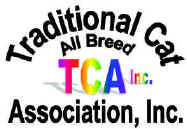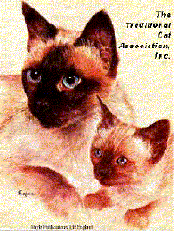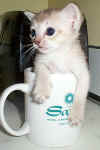
 The
Traditional Cat Association,
Inc.©1987®TM
Official Website
The
Traditional Cat Association,
Inc.©1987®TM
Official Website
Founded 1987, by Diana L.
Fineran
|
" Home of the Traditional Cat"© |
|
Our Motto: To Preserve,
Protect, Perpetuate, and Promote Traditional Cats.© |
|
|
|||||||
|
|
|
|
Photos Courtesy of |
Q: What is the history of the Singapura?
A: As their name suggests the Singapura is a natural breed ,created by Mother Nature, from the gene pool native to the Malaysian, 225 square mile, island of Singapore. This is one of the smallest of all the pedigree breeds. "Singapura" is the Malaysian name for Singapore. Hal and Tommy Meadow are credited with recognizing the striking beauty of this breed. At one time they were known as "local Singapore "drain cats", because it is said they took shelter in the city drains during the dry season, and the "Singapore River Cat", because they supposedly originated on the banks of the river system there. While living in Singapore in 1974 the Meadow's began breeding what has come to be known as the Singapura and imported them to the U.S. in 1975. What makes the Singapura distinctive is its small size and coloring. There is not another breed like them. They are typical of the city, but are not the most common street cat in Singapore. In 1965 a TICA Judge saw them in their native land, as well as several other people living or visiting the island. It is the general view that a cat of this type has been present in Singapore for at least 300 years and is a well established, ancient breed.
The story of their discovery and eventual status as a recognized breed is fascinating. Tommy Meadow had been in the U.S. cat fancy for 20 years by then, having been a breeder of Burmese, Siamese and Abyssinians. Then in 1970 she met and married Hal Meadow, a geophysicist whose work for an oil company repeatedly took him to the Far East, including Singapore. While there in 1971, doing confidential marine surveys for an oil company out of a port called Loyang in the north east part of the island, Hal noticed three "ships cats" on one of the marine survey vessels with ticked coats, like the Abyssinian, yet with a more silvery coloration. Recognizing them as being unusual, he had three of them shipped back to Houston, Texas on one of the work boats. About six months later, he obtained a fourth cat of this type from a local sailor in the harbor at Loyang, which was shipped back to his wife in the U.S. Therefore a total of four Singapura, a male and three females, were kept pure and bred through two generations in the U.S.
It was in 1974 when Hal and Tommy traveled back to Singapore together, intending to stay there for ten years. They were accompanied by a few of her cats, including three grandchildren of the unnamed original four. The three, owned by the Meadow's, from whom the breed sprung. were, Puss'e, a young female, Ticle, a male, and Tessa, his female littermate. The Meadow's began breeding the Singapura in Singapore.
The first litter born of a deliberate breeding program had Ticle as their sire and Pusse as their dam. The male and two female kittens were all brown ticked on an old ivory base, with no white and no kinked tails. They were promptly named George and Gladys. The fall of Saigon triggered the exodus of the Meadow's and their brood of Singapura cats: Ticle, his sister, Tes, Pusse, and the kittens George and Gladys. Thus five Singapura cats and Fat Cat, their altered, Sable Burmese, entered the U.S. on July 1, 1975 at Honolulu, Hawaii. They went about the business of establishing this breed and gaining official recognition for it late in 1975.
Through a search by vacationing, Brad , a Flying Tiger Caption, and Sheila Bowers, a female was found, meeting the Breed Standard (except for the tail), straight from the drains of Singapore in the SPCA there. It took some convincing before the SPCA Veterinarian, Dr. Lee, would release the female as a whole cat, since she was leaving the country. They did also see cats described as Singapuras at night in the bushes and along the drains. None were captured, however. They imported this important female to Barbara Gilbertson, then of Tacoma, WA. on April 22, 1980. Her name was Chiko, who is behind many Singapura pedigrees today. More importantly she came with full documentation proving that the Singapura cats exist in Singapore.
Barbara Gilbertson became the first breeder, other than the Meadow's, to own and breed a pair of Singapura. Their names were, 'Rummy" the female, and "Thumper' the male.
In 1987 Gerry Mayes, a retired engineer and early Singapura breeder went to Singapore for three months to find and import more Singapura cats to the U.S. With the help of the Singapura Cat Club there he was successful in bringing back several Singapuras.
After 90 kittens had been produced in the U.S. from these original Singapura cats, some range in the intensity of ticking and in the intensity of the old ivory ground color occurred, but with a few exceptions all were brown ticked on old ivory. The only other anomaly in color was the appearance of solid brown kittens. Through test breedings cats carrying the solid colored gene were singled out and altered. The reigning decision among Singapura breeders was that only the ticked kittens would be carried on. A note was made of each litter that had a solid brown kitten in it in order, which was not registered, to make a record.
Type had to be fixed as well. Ticle, the original male grew to be a large, very dark ticked cat, with heavy leg barring, with a much longer than average head. This head type was passed on to his kittens. Yet, he was the best to be found with no white and no kink in his tail. Later his sons and grandsons took over his duties to set the type of the breed. In 1988 the numbers of Singapura in the U.S. was estimated around 500. By the mid-90's there were about 2,000. A pregnant female, Faye Raye, was the first Singapura imported to England on July 25, 1988. A few weeks later, while still in quarantine she gave birth. Interest grew in the 1990's and by 1995 there were about 30 Singapura in Great Britain.
Only one coloration and pattern is allowed in the small to medium Singapura cat. This is a ticked (agouti) coat similar to that found in the Abyssinian, squirrels, gophers and rabbits. Ticking refers to the different colored bands on each hair shaft, which is dark brown ticking on an old ivory ground color with the underside the color of unbleached muslin.
The Singapura develops slowly, coming in season for the first time usually at 15 to 18 months. Males take at least until the age of 1 1/2 years to get interested in breeding. A usual litter is from 2 to 3 kittens with 4 kittens born occasionally. Around 5 weeks of age is when kittens start coming out of their box, even if there is a low door. At a year old, a Singapura female is about the size of an American Shorthair 5-6 month old kitten. Some are smaller.
There is some irony in this breeds history. It clearly did come from the drains or culverts in Singapore. The government there went about a vigorous "clean Up" project to eliminate stray cats and their habitats, then turned around and declared the Singapura to be a "Living National Monument'! The Singapore 'Tourist and Promotion Board in 1991 placed statues of the Singapura along the river and began featuring the Singapura in all types of promotional material. The breed was given the breed name of "Kueinta" for placement on these statues. Even more ironic is the fact that the cats used as models for the statues are owned by a couple residing in Singapore, but their cats were imported from the U.S.!
Q: What about the health of the Singapura?
A: At first some kittens with laterally flattened rib cages were born. It was found that a lack of potassium iodide in the diet had kept the kittens from utilizing calcium even though calcium was heavily supplemented. Since potassium iodide is readily available in ocean fish, by feeding canned tuna the deformity was eliminated. No other congenital deformities, such as cleft palates or spina bifida have been seen.
Q: What about the personality of the Singapura?
A: They have a delightful, aggressively affectionate disposition with a tendency to be shy. Consumed by a gigantic curiosity, they quickly over come the shyness. The word "stranger" is not in their vocabulary. They remain playful as adults. They are such excellent mothers they would like to go on nursing the kittens until the next litter is due! With a common sense attitude they are everywhere where people are, insisting on helping with everything from cooking, to newspaper reading, and in general getting into the middle or on top of whatever you are doing. They are "under cover cats" because most prefer to sleep under the covers of your bed with you. However, most probably they will remain at the foot of the bed waiting to be asked. Possessing a low key way of getting exactly what it wants, you give in to their charms quickly. They like to "wash" people like dogs do, staying tuned in to people's moods. Some have called them "groupies" since they are social, seldom squabble and group around people, including visitors. However, they are not demanding and are always gentle. Even in season they have quiet voices. Most interesting is the stud males, who prefer living together with other Singapura studs. There is no fighting.
Currently the breed is as approximately 10 to 12 generations from the original three cats from 1975 (two were littermates) and one more cat from 1980. There are murmurings among its supporters that more imported blood is needed to keep the breed viable and strong. TCA, Inc. intends to prudently assist in this regard, both with our Registry and with importations.
By Diana Fineran
Copyright June 8, 2000
|
The Traditional Cat Association, Inc.©1987®TM ALL RIGHTS RESERVED © by John & Diana Fineran - Aug 1999- 2025 No portion of this website or any information contained within it may be copied, or in any way distributed, without the expressed written permission of John or Diana Fineran - No exceptions. |

